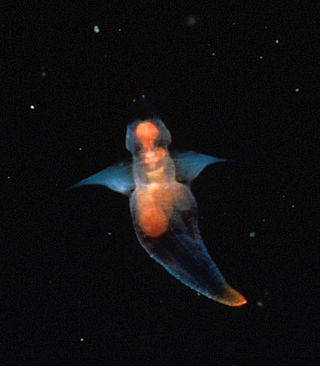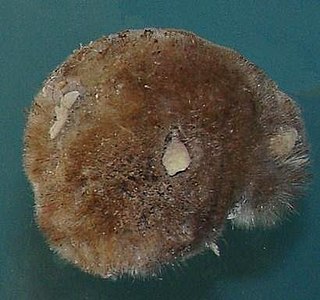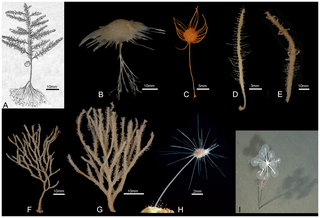
Sponges, the members of the phylum Porifera, are a basal animal clade as a sister of the diploblasts. They are multicellular organisms that have bodies full of pores and channels allowing water to circulate through them, consisting of jelly-like mesohyl sandwiched between two thin layers of cells.

The Clionidae are a family of sea angels, which are a group of pelagic marine gastropods.

Demosponges (Demospongiae) are the most diverse class in the phylum Porifera. They include 76.2% of all species of sponges with nearly 8,800 species worldwide. They are sponges with a soft body that covers a hard, often massive skeleton made of calcium carbonate, either aragonite or calcite. They are predominantly leuconoid in structure. Their "skeletons" are made of spicules consisting of fibers of the protein spongin, the mineral silica, or both. Where spicules of silica are present, they have a different shape from those in the otherwise similar glass sponges. Some species, in particular from the Antarctic, obtain the silica for spicule building from the ingestion of siliceous diatoms.

Cladorhiza is a genus of carnivorous sponges, comprising around 40 species found in oceans around the world. Cladorhiza is the type genus of the family Cladorhizidae.

Hexasterophora are a subclass of glass sponges in the class Hexactinellida. Most living hexasterophorans can be divided into three orders: Lyssacinosida, Lychniscosida, and Sceptrulophora. Like other glass sponges, hexasterophorans have skeletons composed of overlapping six-rayed spicules. In addition, they can be characterized by the presence of hexasters, a type of microsclere with six rays unfurling into multi-branched structures.

Chondrocladia is a genus of carnivorous demosponges of the family Cladorhizidae. Neocladia was long considered a junior synonym, but has recently become accepted as a distinct genus.

Polymastiidae is a family of demosponges found in oceans throughout the world. It is the only family in the monotypic order Polymastiida. A useful diagnostic characteristic of members of this family is the presence of numerous surface papillae although this feature is shown by some other sponges.

Clathrina coriacea is a species of calcareous sponge belonging to the class Calcarea and family Clathrinidae. Species in the genus Clathrina are composed of calcium carbonate tube-like skeletons containing spicules. The sponge can be located in shallow waters widely distributed along North Atlantic coasts, as well as on other coasts.

Cladorhizidae is a family of carnivorous demosponges found in deep-sea environments worldwide. These sponges are known for their unique feeding structures and predatory behavior, as they capture and consume small animals such as crustaceans.
Cladorhiza caillieti is a carnivorous sponge of the family Cladorhizidae described in 2014 from specimens collected from the Juan de Fuca Ridge off the coast of Vancouver Island. It feeds on small crustaceans such as amphipods and copepods. C. caillieti is an elongate, bottlebrush-shaped sponge with filaments projecting from a main stem, and ranges from 7 to 9 cm in height. The specific epithet honors Dr. Gregor M. Cailliet of the Moss Landing Marine Laboratories.

Verongiida is an order of sea sponges within the phylum Porifera. The "skeleton" in these sponges is made up of spongin, rather than of spicules. They live in marine environments. The name was proposed by Patricia Bergquist in 1978.

Crambe crambe, commonly known as the oyster sponge or orange-red encrusting sponge, is a species of demosponges belonging to the family Crambeidae.

Coelosphaeridae is a family of sponges belonging to the order Poecilosclerida. Species are found across the globe.
Latrunculia biformis, the mud-clump sponge, is a widespread deep sea demosponge from the southern hemisphere.
Phyllis Jane Fromont is a New Zealand and Australian scientist specialising in sponges.

Abyssocladia is a genus of the family Cladorhizidae, a family of carnivorous sponges. It is made up of at least 39 species found in oceans all over the world.

Robertus Wilhelmus Maria (Rob) van Soest, born in 1946, is a Dutch marine biologist. He works at the Naturalis Biodiversity Center and is also affiliated with the University of Amsterdam. He co-authored with John N. A. Hooper Systema Porifera: A Guide to the Classification of Sponges, a standard reference for sponge classification.

Monanchora is a genus of demosponges belonging to the family Crambeida. The genus contains 18 species, which have been researched for their potential use in medicine.
Axoniderma australis is a species of demosponge in the family Cladorhizidae. It is known from type specimens found off the coasts of Tasmania and New South Wales.
Axoniderma kensmithi is a species of demosponge in the family Cladorhizidae. It is known from type specimens found in the Pacific Ocean off the coast of California.















